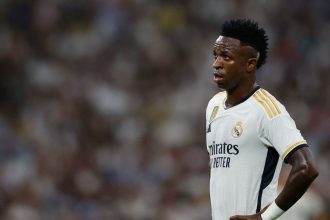The U.S. beach squad, a mixture of ex-pros and futsal stars led by an Irish coach, now on the brink of a fourth straight World Cup
You can see them in a strip of beach in Miami, every Saturday, rain or shine – kicking a soccer ball around on the golden sand. It’s thick and deep. You can’t really run. Sometimes it’s just 10 players. Other times, the numbers reach 20. The rules are simple: five a side, goalkeepers get involved in the play, no offsides.
The goals fly in as the sun rises. There is always music blasting, maybe a swim at the end, and then it’s back to normal life. Remove the sand, swimming and sunrise, and it’s the kind of pick up soccer that happens anywhere and everywhere, on pitches, courts and grassy fields around the globe.
But for Nico Perea, defender for the U.S. Men’s Beach Soccer National Team – and two-time national player of the year – it’s the perfect way to stay sharp. He is one of a select few athletes in the U.S. who compete in beach soccer at an elite level. He has 34 caps for the national team, in fact, and has played in the World Cup – yes, there’s a World Cup for beach soccer – and is a mainstay at the back for the reigning CONCACAF Champions.
Still, this is a wild bunch, a mixture of ex-pros, indoor stars, and soccer-lovers – some with no apparent background in beach football whatsoever – piecing together a squad capable of competing for the United States.
“I didn’t even know this was a ‘thing’ at first,” Perea told GOAL. “But you’re telling me I can represent my country at it? It’s a dream come true.”
United States SoccerWhere they come from
Beach soccer is not a full-time profession in the United States. Some of the players also compete in professional indoor soccer. Others have normal day jobs and then train by themselves. Perea works a corporate job in Miami, then spends his nights working on his passion.
Alessandro “Sancho” Canale, the second-all-time leading beach goalscorer for the U.S., has his own clothing brand, advises other brands, plays for an indoor team in Washington, and also finds time to kick a ball around on the beach.
The national team players are paid a daily rate – a relatively recent development, at that – but rely on income from elsewhere to pay the bills.
“Probably half the time that I've been on the team, we weren't getting paid, and maybe the first four years, or five years,” Canale said.
But make no mistake, there is a real professionalism here. Beaches are rented for a minimum of four camps per year. And the new United States Soccer training center in Atlanta will feature separate facilities for the sport on sand.
AdvertisementUS SoccerHow it all works
Beach soccer differs from the beautiful game in its traditional format. There are five players on each team, including the goalie. And that’s more or less where whatever similarities end.
There is no half time – games are played in three 12-minute periods. There is no offside, and throw-ins can be kicked off the ground. Everyone is barefoot. Bicycle kick goals are so common that a rule had to be implemented preventing defenders from touching opposing forwards when they are off the ground (it makes the highlights immaculate viewing.) The ball is in the air a lot of the time – passing on uneven sand is largely unpredictable.
In most cases, the pitch has to be cleared of pebbles and shells before kickoff to prevent injury. Goals are smaller than usual, just six yards across. The pitch is tight, too, roughly 40 yards long and 30 wide. Substitutions are done on a rolling basis, making this thing look far more like shifts in ice hockey than soccer. No one can run on sand for a full game. In a matchday squad of 12, most – except the backup goalie – can expect to play.
A baseline of skills are applicable from 11v11 soccer, but the best players tend to be experienced in futsal or small-sided soccer. Still, this is its own thing.
“It is unlike any other sport – and unlike outdoor soccer, it's unlike indoor soccer,” Canale said.
And the sport is global. Beach Soccer Worldwide was founded 1994, and sponsored, officially, by FIFA in 2005 – 142 different countries have registered national teams. A World Cup has been held every other year since FIFA’s endorsement. The best teams are who you might expect: Brazil, Portugal, Spain. But Russia, Japan and Italy are all strong in their own right.
US Soccer'I was just looking for a team'
The U.S. team, meanwhile, are ever-improving. The last FIFA rankings had them at No. 15. Part of their challenge is that there is no professional infrastructure for the game in the United States. Perea’s pickup may be a scenic, idealized version of the game, but for a long time, it’s how many learned to play.
But the lack of an official organizing body – outside of the U.S. national setup – has given rise to some wonderful stories, and unique talents. The U.S. national team consists of a group of former USL players, ex-college talents, and futsal stars.
Perea, for one, stumbled across the game when his career had reached a dead end. He was a part of USL Championship side Indy Eleven in 2019, and still looking for a club when the COVID-19 pandemic shuttered sport around the world. With nowhere to play, he moved back to his native Miami. And there, an opportunity arose.
“I was just looking for a team, talking to my agent, trying to feel out the situation. And then the pandemic hit. Everything shut down. As you know, there was not much to do. The league was in a pause, and I was back home in Florida,” Perea said.
He reverted back to all of the things he had done as a kid – running on the beach, training on the sand. He used to go out to the ocean with his father in his youth, practicing headers into the water and working on his touch as the waves broke. A friend introduced him to beach soccer in full. Perea was told there would be a training session on the beach. Perea agreed to attend – without the crucial clarifying detail as to what exact sport he might be playing.
As it turned out, the session was run by the then-beach national coach Francis Farberoff. He was using the games as a quasi-scouting session. There were players from all over the world, Perea said, including Europe, Latin America and the U.S. But the man on the sidelines paid special attention to the Americans. Perea, a commanding center back with an excellent first touch, was swiftly invited to play for the team.
“Once they told me about the opportunities, like, ‘Hey, we travel, we play important competitions, you get to be home,’ I was just like, ‘Let's just try this beach thing out,’” Perea said.
For Canale, things were more complicated. The forward was at a crossroads in his career, soon to transfer from Santa Monica City College to UC San Diego to pursue 11v11 soccer. Upon the recommendation of a friend, he was introduced to Eddie Soto – then the U.S. beach head coach.
Soto told Canale that he needed extra players for a scrimmage in Seal Beach – two hours away from his native Venice. Canale, ever desperate to kick a ball, made the drive on the promise of a couple of hours of fun. This was not, Soto insisted, an official invitation to the camp.
Still, Canale impressed in the first scrimmage, and stayed the night before playing in the second. By his third day with the team, he was wearing a U.S. national team training shirt and in Soto’s plans for the squad.
There were issues, though. College soccer season was approaching. Canale was still enrolled at UCSD and had a winter of 11 a side ball to play. He managed to negotiate around it, and represented the U.S. at the beach World Cup that winter.
“I wasn't really sure if it'd be the best move for me to go,” Canale admitted. “But at the end of the day, like it didn't make sense to not. It was an opportunity that I couldn't pass up.”
Back to front, the whole thing took three months before Canale was kicking a ball in Tahiti.
Getty Images'I was delighted to have the opportunity'
Beach soccer really wasn’t a thing where Ian Carry was raised. He grew up in Ireland, and played at a professional level in Scotland before going into coaching. Stints in indoor football followed, with a few caps for the Irish National Team as a goalkeeper.
In 2007, Carry returned to Ireland with a promise that, this time, he would stay.
“I moved from Scotland back to Ireland in 2007 and was never, never, ever going to move again. This is it. Final stop,” Carry said.
So much for that. A friend in the game invited him to coach college kids in America over the summer. Given his coaching career in the Celtic, Carlisle United and Dundee United senior setups, as well as a variety of academy age groups for the Irish national team, it made sense – if only for a summer holiday.
Then, a job opportunity arose: head coach of Central Michigan University women’s team. Carry broke his own promise, moved to America, and hasn’t looked back since. Jobs at the University of Kentucky and Charlotte Soccer Academy – where he is currently in a full-time role – followed.
Beach soccer happened by chance. In November 2022, Stuart Sharp, an old friend who works for U.S. soccer, told Carry that the Beach team needed a goalkeeping coach. Carry’s response? Why not? There was, admittedly, one problem: Carry had never played beach soccer in his life.
“I was like, awesome. I was delighted to have the opportunity,” Carry said.
He worked his way through the ranks from there, served briefly as interim head coach, and after changes at the federation, was invited to apply for the role full time in early 2024. His club coaching career needed to be negotiated. But he figured everything out with his other job, and after impressing in his interviews, was named head coach in July of that year.
“Not everybody gets the opportunity to say that coach of a national team, let alone, the U.S. national team,” Carry said.
For Carry, there was an issue with the competitiveness around the team. He wanted to foster a sense of intensity among the group – which he believes has the talent to compete at the World Cup. His immediate solution was to gameify everything. Soccer trivia is a staple of his camps. Players are required to rank each other player from most to least competitive.
For Canale, Perea and co., it’s a driving force.
“I love the fact that he brought that in,” Perea said. “It brings the competitiveness out of everybody to know that in every single situation, every single play, every single moment, you should be going 100 percent.”
When they go home from camp, and are sent training regimens, they are required to match – or, ideally, beat the statistic set from previous meetups collected by the team’s performance scientist.
“With a staff that ticks every single box there's no stone unturned,” Carry said. “We just need to put these guys into the best possible physical shape and mental state. And then technically and tactically, from the coaching standpoint, we go to give them the best opportunity to be successful.”






